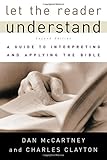Let the reader understand : a guide to interpreting and applying the Bible / Dan McCartney, Charles Clayton.
Material type: TextPublication details: Phillipsburg, N.J. : P&R Pub., c2002.Edition: 2nd edDescription: ix, 378 p. : ill. ; 23 cmISBN:
TextPublication details: Phillipsburg, N.J. : P&R Pub., c2002.Edition: 2nd edDescription: ix, 378 p. : ill. ; 23 cmISBN: - 0875525164 (pbk.)
- 220.6/01 21
- BS 476 .M333 2002
| Current library | Collection | Call number | Vol info | Status | Date due | Barcode | |
|---|---|---|---|---|---|---|---|
| Judith Thomas Library General Stacks | BKS | BS 476 .M333 2002 (Browse shelf(Opens below)) | AUA001375 | Available | AUA001375 |
Includes bibliographical references (p. 313-363) and indexes.
Contents:
Introduction: God's Word and human understanding: What is the problem? --
Part One: The foundation of understanding: Presuppositions --
1. Truth, language, and sin --
The pillar of understanding: Truth --
The vehicle of understanding: Language --
The spoiler of understanding: Sin --
Summary --
2. Knowing God: Presuppositions about the Bible and creation --
Is the Bible the Word of God? --
Is the Bible true? --
Is the Bible coherent? --
The Bible and the world --
3. The foundation and the frame: Presuppositions and interpretation --
Presuppositions and method --
Tradition and the church --
The Holy Spirit: The ultimate interpreter --
Part Two: Interpretation in theory --
4. The church and biblical interpretation --
The early church: Justin Martyr and Irenaeus --
The developing church: Origen and Theodore --
The Middle Ages: Aquinas --
The Reformation: Luther and Calvin --
The modern church: From Schleirmacher to Bultmann --
The literary turn: From literary criticism to postmodernism --
Summary --
5. The grammatical-historical method: Knowing what it meant --
Meaning and understanding semantics --
Culture and understanding --
Context and understanding --
Genre and understanding --
6. Removing the veil: From what it meant to what it means --
History and beyond --
Typology and "fuller meaning" --
The Bible interprets itself --
Redemptive history and present application --
Conclusion. Part Three: Interpretation in practice --
7. Studying God's Word --
Spiritual preparation --
Analyzing passages --
Understanding the Bible on its own terms --
Priorities of interpretation --
Two examples --
8. Biblical genres --
Theological history --
Law --
Poetry --
Prophecy --
Parables --
Epistles --
Apocalyptic --
9. The Bible in worship and witness --
Scripture and worship --
Scripture and witness --
10. Scripture and guidance --
Guidance needs to be in context --
What is "God's will"? --
Submission to God --
Understanding God and His ways --
Understanding God's sovereignty --
Conclusion --
Appendix A: Where is meaning? --
Authorial intent --
Autonomous texts --
Reader response --
Conclusion --
Appendix B: The historical-critical method --
General description and evaluation --
"Scholarly" methods.
